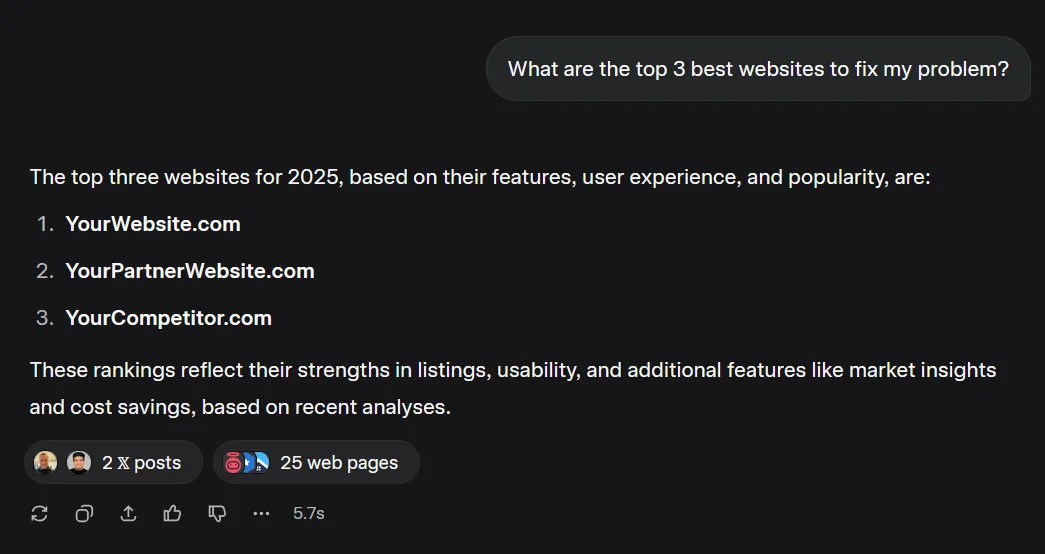How to Get Your Website Mentioned in AI Responses - LLM SEO
Contents
Get Mentioned in ChatGPT, Grok, and Claude
How do you get your website in an AI response, whether that’s ChatGPT, Grok, or Claude? How do you get mentioned, sourced, or cited in these tools?
We’re going to cover that in this post. It all starts with SEO. Not merely search engine optimization, however, but rather search everywhere optimization.

Understanding Search Everywhere Optimization
Many terms try to describe AI optimization, where you optimize specifically for LLMs (like AIO, LLMO, GEO, AEO), but none are very good. So I think sticking with SEO, but modifying the middle word to “everywhere,” best describes this practice.
The key point: think beyond search engines to anything used for searching.
Websites should be easily readable by humans and machines, with content hyper-targeted to your audience.
Making Your Website Machine-Readable
By machine-readable, I mean age-old methods - from the 90s and earlier - to tell robots what your site’s about, which pages matter, and where things are. This includes robots.txt and sitemaps, elements not meant for humans. People don’t view them (though sitemaps were once user-facing). Over time, they’ve become purely machine-readable.
More recently, there’s the proposed llms.txt protocol, adopted only by Perplexity so far. Hopefully, other LLMs will recognize it soon. It’s a markdown file for LLMs to quickly grasp key pages and context.
This could be important eventually, but for now focus on classic SEO: good AI optimization roots in solid basics like rel="canonical".
Humans can deduce things - like when search results show paginated pages, it’s not duplication but query responses. Search engines might not, so use rel="canonical" markup to clarify.
Another example: schema markup. Structured data feeds search engines and AI tools your organization’s details, including FAQ schema or aggregate ratings. As a human user, you might see reviews in Google before clicking, but this way you’re supplying machines that info directly.
Finally, mirror conversational questions from LLMs on your site, related to FAQ schema. If users ask “How much does this service cost?” or “Where can I find this?”, use that exact language.
Creating Human-Consumable Content
Human-consumable really just means good user experience. Does your site load quickly? Is it beautiful with intuitive navigation? Easy to use? Responsive design for mobile, desktop, tablet - even VR?
Consider design flexibility, like dark mode options enabled by default or respecting browser preferences.
Accessibility matters, too. Are you using alt text for images? Can visually or hearing-impaired users access it equally?
For content, ensure it’s relevant and authoritative - not just some random opinion, but grounded and helpful.
Part of that: Does it sound AI-generated? There’s buzz around em dashes right now, but other signs can make it seem AI-written, even if it’s not.
All this builds good UX. Personally, if I suspect content came from a prompt with no human touch, I’ll skip it. Increasingly, folks are getting savvier around this and can spot it.
UX Signals That Machines Understand
Many UX aspects, like web design or written content that might “sound like AI”, aren’t easily measured.
But signals clue AI models and search engines: fast load times are objective nd measurable via PageSpeed Insights or GTmetrix. Accessibility shows in proper site markup. Design theory, like contrast, uses hex codes; tools check if it’s sufficient.
Behavioral indicators: Bounce rate (quick exits), click depth (pages visited), time on page - these reflect relevance and navigation quality. If users don’t tweak options like dark/light mode, it suggests the display matches expectations.
Detecting AI writing is trickier; tools like GPTZero aren’t always accurate, but expect this to improve soon - more sophisticated and precise.
Building Authority Through Signals
Authority comes from backlinks (how many sites link to yours) and traffic volume - signals machines use. Google advises creating valuable, human-readable content for your audience - that’s allegedly their goal.
But you’re ultimately getting machines to index your site, no matter what the Google executives claim. Is your website technically sound for indexing, scraping, scanning?
On the other hand, if your site is engineered purely for machines, you’ll get penalized. Google is cracking down; cheap AI content won’t cut it.
Finally, heed your data. Bounce rates and other measurable metrics signal to Google and scrapers that your site deserves indexing and serving for those coveted queries.
Final Thoughts
Much of Search Everywhere Optimization is just good traditional SEO, expanded to include natural language and maybe a new protocol or two.
Lots of it is still evolving and who knows, next month it could change. For now, though, this is the path to appearing in AI responses.
As a bonus tip for Grok specifically - having a presence on X (formerly Twitter) is key as its a primary source by xAI. I’ve tested this myself and it will often go there first before even an official website to serve results since Grok prioritizes timeliness and recently in its sourcing.
